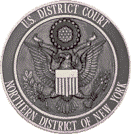Top Qs
Timeline
Chat
Perspective
United States District Court for the Northern District of New York
United States federal district court in New York (U.S. state) From Wikipedia, the free encyclopedia
Remove ads
The United States District Court for the Northern District of New York (in case citations, N.D.N.Y.) serves one of the 94 judicial districts in the United States and one of four in the state of New York. Appeals from the Northern District of New York are taken to the United States Court of Appeals for the Second Circuit, which has jurisdiction over the four districts of New York, the District of Connecticut and the District of Vermont (except for patent claims and claims against the U.S. government under the Tucker Act, which are appealed to the Federal Circuit). The U.S. attorney for the district is Carla B. Freedman since October 8, 2021.[3]
Remove ads

Its jurisdiction comprises the counties of Albany, Broome, Cayuga, Chenango, Clinton, Columbia, Cortland, Delaware, Essex, Franklin, Fulton, Greene, Hamilton, Herkimer, Jefferson, Lewis, Madison, Montgomery, Oneida, Onondaga, Oswego, Otsego, Rensselaer, Saratoga, Schenectady, Schoharie, St. Lawrence, Tioga, Tompkins, Ulster, Warren, and Washington.
The court's main offices are in Syracuse, however, the court has additional offices in Albany, Binghamton, Plattsburgh, and Utica. The court also maintains facilities in Watertown. The court accepts filings from members of the bar through an automated case management system CM/ECF over the Internet.
Remove ads
History
The first federal court district formed under the sovereignty of the United States was the District of New York. The District Court for the District of New York convened on November 3, 1789, with Judge James Duane presiding. On April 9, 1814, that original district split into the Northern and Southern Districts of New York; the first federal judge of the District Court for the Northern District of New York was Matthias Burnett Tallmadge. The Northern District's western area split off in 1900 and became the Western District of New York. The Northern District now covers thirty-two counties in upstate New York, and it shares its long northern border with Canada.
Remove ads
Current judges
As of December 9, 2024[update]:
Remove ads
Former judges
- Recess appointment; formally nominated on December 20, 1805, confirmed by the United States Senate on December 23, 1805, and received commission on January 17, 1806.
- Reassigned from the District of New York.
- Recess appointment; formally nominated on January 3, 1820, confirmed by the Senate on January 5, 1820, and received commission the same day.
- Recess appointment; formally nominated on December 13, 1825, confirmed by the Senate on December 14, 1825, and received commission the same day.
- Recess appointment; formally nominated on December 2, 1902, confirmed by the Senate on December 8, 1902, and received commission the same day.
- Recess appointment; formally nominated on December 6, 1927, confirmed by the Senate on December 19, 1927, and received commission the same day.
Remove ads
Chief judges
Chief judges have administrative responsibilities with respect to their district court. Unlike the Supreme Court, where one justice is specifically nominated to be chief, the office of chief judge rotates among the district court judges. To be chief, a judge must have been in active service on the court for at least one year, be under the age of 65, and have not previously served as chief judge.
A vacancy is filled by the judge highest in seniority among the group of qualified judges. The chief judge serves for a term of seven years, or until age 70, whichever occurs first. The age restrictions are waived if no members of the court would otherwise be qualified for the position.
When the office was created in 1948, the chief judge was the longest-serving judge who had not elected to retire, on what has since 1958 been known as senior status, or declined to serve as chief judge. After August 6, 1959, judges could not become or remain chief after turning 70 years old. The current rules have been in operation since October 1, 1982.
Remove ads
Succession of seats
Summarize
Perspective
Remove ads
See also
References
External links
Wikiwand - on
Seamless Wikipedia browsing. On steroids.
Remove ads

